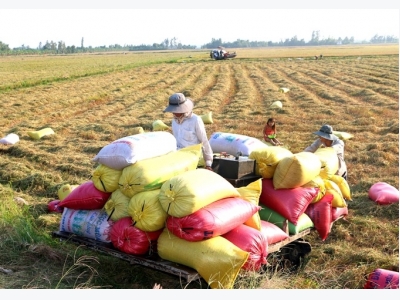2018 rice export to hit 6m tonnes

Merchants gather rice pallets in the fields in southern Hậu Giang Province. — VNA/VNS Photo Huỳnh Sử
HÀ NỘI — Việt Nam’s rice export volume in 2018 is expected to increase by 400,000 tonnes from 2017 to reach 6 million tonnes, due to increased demand from Southeast Asia, especially from the Philippines, with China expected to be the country’s largest rice market.
The Vietnam Food Association (VFA), in a report earlier in January, said countries in Southeast Asia will import a large amount of rice from Việt Nam, helping boost the country’s turnover this year.
The VFA said Indonesia will import rice from Việt Nam and Thailand again in 2018 to increase reserves, as Indonesia’s rice price has been rising, almost double the floor price.
Similarly, the National Food Board of the Philippines approved of up to 250,000 tonnes of imported rice to offset declining inventories, due to unfavourable weather in 2017.
These developments are encouraging for Việt Nam’s rice export market, said the VFA’s report, with export price of 5 per cent broken rice rising to US$400 per tonne from $390.
Domestic rice price also increased, with the average price between to $267 to $293 per tonne as of January’s end, having increased by $13 to $15 per tonne from December 2017’s price.
According to the VFA’s data, throughout 2017, the country exported 5.7 million tonnes of rice worth $2.54 billion.
As mentioned by the US Department of Agriculture (USDA)’s 2018 world rice production forecast, issued late 2017, the main factor behind this year’s rice trade expansion is increased output from Việt Nam, Pakistan and Myanmar, three of the world’s top six rice exporting countries.
The USDA’s report stated that though 2017 global rice output fell by 20 per cent from 2016’s number, as a result of weak outlook for grain products, long, heavy rainfall and spring floods and other unfavourable weather, meaning there should be positive signals from traditional rice importing markets in Southeast Asia in early 2018.
In Bangladesh and Sri Lanka, whose rice crops were heavily influenced by harsh weather, demand for rice imports will also increase in 2018. Rising import demand is supported by increased purchasing power in Africa and the Middle East, while China continues to be a leading importer of rice from neighbouring regions.
As such, Việt Nam will witness an increase in revenue from rice exports to several large consumer markets.
According to the Department of Crop Production under the Ministry of Agriculture and Rural Development, in early January 2018, the Mekong Delta’s rice producers harvested 860,000 hectares of rice, with an average yield of 5.3 tonnes per hectare.
Nonetheless, problems remain for national rice production, the majority of which stem from farmers’ ignorance.
Talking to Vietnam News Agency during a late 2017 agricultural conference in the Mekong Delta, Võ Tòng Xuân, former vice rector of Cần Thơ University and rice expert, emphasised growing competition in global rice markets.
Xuân warned that Việt Nam needs to find ways to make its rice exports stand out if it wants to achieve export targets.
Regarding export rice quality, he was convinced that since rice merchants often mix different batches from different farmers into one large batch, there is virtually no way to completely track the origin of any batch.
Without clear origin, there are no certain product quality controls, and no major national rice brand for Việt Nam, Xuân added.
He suggested issuing contracts between rice farmers and processing plants for sustainable production, via agricultural co-operatives instead of relying on middlemen.
Xuân also said that there remain regulations acting as barriers to small and medium enterprises from entering the rice market. Exporting low quality rice and fragrant rice without a brand name is becoming increasingly difficult for Việt Nam, especially in finding niche markets to sell several thousand tonnes.
Có thể bạn quan tâm
 Asia Coffee-Vietnam market dull, Indonesian exports fall further
Asia Coffee-Vietnam market dull, Indonesian exports fall further Vietnam farmers were reluctant to sell beans due to the recent slump in robusta prices
 Rice export surges 74.2% in January
Rice export surges 74.2% in January The figures represented rises of 56.5% in volume and 74.2% in value as compared with the same month in 2017.
 VN seeks to accelerate agricultural restructuring
VN seeks to accelerate agricultural restructuring Accelerating agricultural restructuring towards large-scale and high-tech production became critical for the sector involving 70 per cent